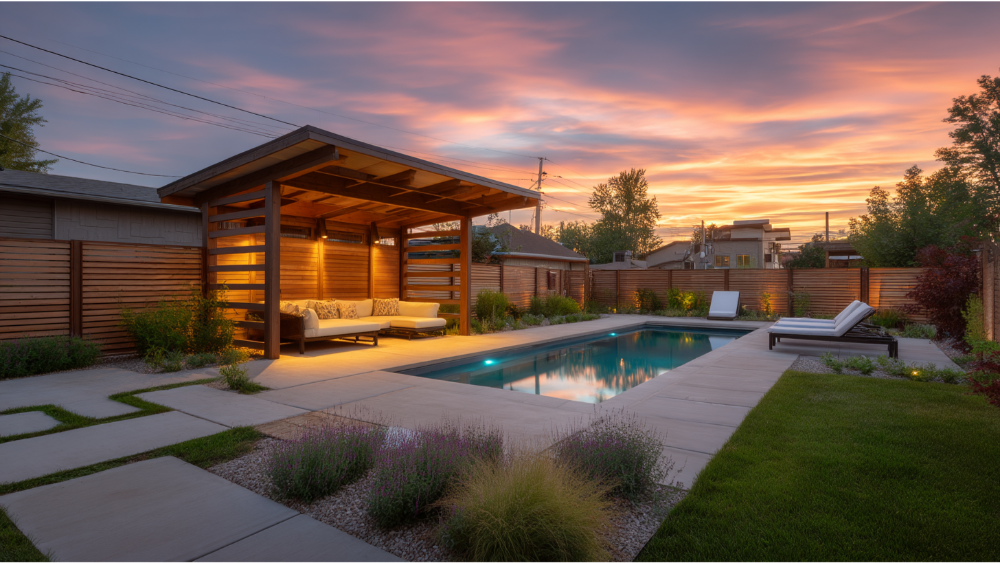Cleaning your wood fence is one of the most important steps in keeping your property looking sharp and protected year-round. Whether you’ve got a classic cedar privacy fence, a decorative pine picket line, or a stained wooden fence surrounding your backyard, regular maintenance is essential. Over time, your fence takes a beating from moisture, dirt, mold, mildew, and general wear. If left untreated, all that grime doesn’t just make your fence look weathered, it can lead to long-term damage like rot, warping, or peeling paint.
In this comprehensive guide, we’ll walk you through exactly how to clean wood fence using safe, effective methods and tools. We’ll also show you the best cleaning solutions to use, what equipment is safe (and what’s not), and how to avoid common mistakes like applying too much pressure with a pressure washer or skipping the essential step of letting your fence fully dry. Whether you’re doing it yourself with a garden hose and scrub brush or calling in the pros for pressure washing, this guide will help you get the job done right.
Why Cleaning Your Wood Fence Is Important

Your fence stands in the elements 24/7. Rain, sun, wind, mold spores, and airborne dirt all stick to the surface, breaking down the wood and stain over time. When moisture gets trapped in the boards, it leads to mildew, rot, and even algae growth. Keeping your wooden fence clean prevents that damage and extends the life of your investment.
In most cases, homeowners can avoid costly repairs or premature replacement by following a few simple cleaning routines every year. Plus, a clean fence just looks better, it boosts your curb appeal and makes your entire yard feel more polished.
Best Time of Year to Wash Your Fence
The ideal time to wash your wood fence is during spring or early fall when temperatures are mild and the air isn’t too humid. You’ll want at least 48 hours of dry weather to allow the fence to fully dry after you rinse it. Avoid cleaning on extremely hot or sunny days since that can cause cleaning solutions to dry too fast and leave streaks or residue.
Garden Hose: Essential Tool for Cleaning
A garden hose with an adjustable spray nozzle is one of the most versatile tools for cleaning your fence. It helps rinse off dirt and cleaning solutions gently without damaging the wood. Using a garden hose for pre-rinsing is a great alternative to pressure washing, especially for smaller fences or delicate wood types.
Tools and Materials You’ll Need

Before you start the cleaning process, gather your materials. The right tools will help you clean effectively without damaging the wood.
Basic Supplies:
- Garden hose with spray nozzle
- Pressure washer or power washer (1,200–2,000 PSI max)
- Scrub brush or stiff bristle broom
- Sprayer or spray wand (for applying cleaning solution)
- Bucket and gloves
- Drop cloth or tarp to cover plants and grass
- Protective eyewear and mask
Cleaning Solutions:
- Dish soap and water for light jobs
- Oxygen bleach for mold, mildew, and grime
- Simple Green (a wood-safe, eco-friendly cleaner)
- Vinegar and baking soda for natural alternatives
- Chlorine bleach (diluted) for stubborn mold, but be careful near plants
Step-by-Step: How to Clean a Wood Fence

Step 1: Inspect and Prepare
Start by walking the full length of your fence and inspecting for damage. Look for loose boards, cracked paint, exposed nails, or signs of rot. Make minor repairs before you begin cleaning. Cover nearby plants, patio furniture, and ground surfaces with a tarp to protect them from runoff. Remove debris like leaves, dirt, and cobwebs with a broom or leaf blower.
Step 2: Pre-Rinse the Fence
Use your garden hose with a spray nozzle or a pressure washer on a medium pressure setting to rinse the entire fence. This will remove dirt, dust, and loose surface grime. Always rinse from the top down to avoid streaks and make sure the surface is ready for your cleaning solution.
Step 3: Apply the Cleaning Solution
Mix your chosen cleaning solution in a bucket or sprayer. For most wood fences, a mix of water and oxygen bleach works well. You can also use Simple Green or a homemade vinegar mix (1 part vinegar, 2 parts water) for a more natural approach.
Spray the solution evenly across one section of the fence at a time. Let it sit for 10 to 15 minutes so it can break down grime, mold, and mildew. This dwell time is an essential step. If you skip it, you’ll end up using too much pressure later, which can damage the wood.
Step 4: Scrub the Fence
Using a scrub brush or broom, work the cleaning solution into the fence with moderate pressure. Focus on one section at a time, and scrub with the grain of the wood. This step takes good ol’ elbow grease, but it’s worth it. For tough stains or thick buildup, apply more cleaner and repeat the process.
Step 5: Rinse Thoroughly
After scrubbing, rinse the fence with clean water using a garden hose or pressure washer. Always rinse from the top down and keep the nozzle at least 12 inches away from the surface. This helps remove dirt, debris, and leftover cleaner without applying too much force.
Using too much pressure or holding the spray wand too close can splinter boards or gouge the wood surface. This is a common mistake when using a pressure washer on a wooden fence, especially softer woods like pine or cedar.
Step 6: Let the Fence Dry Completely
Once your fence is clean, give it time to dry completely. This can take 24 to 48 hours depending on the weather. Letting the wood dry fully is critical if you plan to stain or seal it afterward. Trapped moisture can lead to peeling paint, blistered stain, or mildew growth under the finish. Make sure to wait the full drying time before moving on to the next section of your project.
Optional Step: Apply Stain or Paint

If your fence has faded or hasn’t been sealed in a few years, now’s a great time to apply a fresh coat of stain or paint. A penetrating wood stain adds rich color and protects against UV rays and moisture. Paint can provide bold color but may chip or peel if not applied correctly.
Before staining or painting, make sure the surface is clean, dry, and sanded if needed. This step can make the difference between a finish that lasts for years versus one that flakes off after one season.
What Not to Do When Cleaning a Fence
- Don’t use too much pressure. A high-powered pressure washer can cut into softwood fences and cause serious damage.
- Don’t skip prep. Not inspecting your fence or protecting nearby plants and ground surfaces can result in more work later.
- Don’t mix bleach with other chemicals. Especially ammonia, this creates toxic fumes.
- Don’t stain a wet fence. It traps moisture and ruins the finish.
- Don’t forget to rinse. Leftover solution can leave stains, harm plants, and attract more dirt.
Eco-Friendly Cleaning Tips
If you’re looking for a greener way to clean, skip harsh chemicals and try vinegar or baking soda. Mix vinegar and water in a spray bottle and apply it directly to mildew or mold. Sprinkle baking soda over stubborn spots and scrub with a brush. These natural solutions work best for light cleaning and are safe around kids, pets, and gardens.
When to Hire a Professional
While many homeowners can handle basic cleaning with a hose and elbow grease, there are times when calling in a pro makes sense. If your fence has extensive mold or grime, hasn’t been cleaned in years, or you’re worried about using the wrong pressure, let a professional fence cleaning service handle it. At Inline Security Fence, we use professional-grade equipment and wood-safe cleaners to restore your fence without causing damage.
Frequently Asked Wood Fence Cleaning Questions
What’s the best way to clean a wooden fence?
Use a safe cleaning solution like oxygen bleach or Simple Green, rinse thoroughly with a garden hose or pressure washer, scrub gently with a brush, and allow the fence to dry before sealing or staining.
Can I use bleach to clean my fence?
Yes, but only diluted bleach and never around plants. Always rinse thoroughly to avoid residue or damage.
How often should I clean my wood fence?
Once or twice a year is ideal, depending on your climate. Fences near trees or shaded areas may need more frequent cleaning.
What’s the difference between a power washer and pressure washer?
Both machines use pressurized water, but a power washer includes a heating element that’s typically not necessary for fences. Pressure washers are safer and more commonly used for wood surfaces.
Should I sand my fence after washing?
If you plan to stain or paint, lightly sanding helps the finish adhere and smooths any raised grain caused by pressure washing.
What’s the best cleaner for mold and mildew?
Oxygen bleach is ideal for killing mold spores and cleaning mildew without damaging wood. Vinegar is a good natural alternative for light growth.
Final Thoughts
Knowing how to clean a wood fence properly can save you thousands in repairs and replacements down the road. Whether you use a pressure washer, scrub brush, or just a garden hose and good ol’ elbow grease, keeping your fence clean should be part of your regular maintenance routine. Use the right cleaning solution, be careful with your pressure settings, and give your fence the protection it deserves.
Need help cleaning, staining, or repairing your wood fence? Contact Inline Security Fence for professional service and long-lasting results you can trust.




